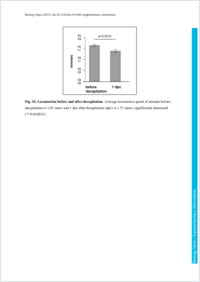Functional brain regeneration in the acoel worm Symsagittifera roscoffensis
- Sprecher, Simon G. Institute of Developmental and Cell Biology, Department of Biology, University of Fribourg, Switzerland
- Bernardo-Garcia, F. Javier Institute of Developmental and Cell Biology, Department of Biology, University of Fribourg, Switzerland
- Giesen, Lena van Institute of Developmental and Cell Biology, Department of Biology, University of Fribourg, Switzerland
- Hartenstein, Volker Department of Molecular, Cell and Developmental Biology, University of California, Los Angeles, USA
- Reichert, Heinrich Biozentrum, University of Basel, Basel, Switzerland
- Neves, Ricardo Department of Molecular, Cell and Developmental Biology, University of California, Los Angeles, USA
- Bailly, Xavier UPMC-CNRS, FR2424, Station Biologique de Roscoff, France
- Martinez, Pedro Departament de Genètica, Universitat de Barcelona, Spain - Institució Catalana de Recerca i Estudis Avançats (ICREA), Barcelona, Spain
- Brauchle, Michael Institute of Developmental and Cell Biology, Department of Biology, University of Fribourg, Switzerland
-
15.12.2015
Published in:
- Biology Open. - 2015, vol. 4, no. 12, p. 1688–1695
English
The ability of some animals to regrow their head and brain after decapitation provides a striking example of the regenerative capacity within the animal kingdom. The acoel worm Symsagittifera roscoffensis can regrow its head, brain and sensory head organs within only a few weeks after decapitation. How rapidly and to what degree it also reacquires its functionality to control behavior however remains unknown. We provide here a neuroanatomical map of the brain neuropils of the adult S. roscoffensis and show that after decapitation a normal neuroanatomical organization of the brain is restored in the majority of animals. By testing different behaviors we further show that functionality of both sensory perception and the underlying brain architecture are restored within weeks after decapitation. Interestingly not all behaviors are restored at the same speed and to the same extent. While we find that phototaxis recovered rapidly, geotaxis is not restored within 7 weeks. Our findings show that regeneration of the head, sensory organs and brain result in the restoration of directed navigation behavior, suggesting a tight coordination in the regeneration of certain sensory organs with that of their underlying neural circuits. Thus, at least in S. roscoffensis, the regenerative capacity of different sensory modalities follows distinct paths.
- Faculty
- Faculté des sciences et de médecine
- Department
- Département de Biologie
- Language
-
- English
- Classification
- Biological sciences
- License
- License undefined
- Identifiers
-
- RERO DOC 258322
- DOI 10.1242/bio.014266
- Persistent URL
- https://folia.unifr.ch/unifr/documents/304719
Other files
Statistics
Document views: 157
File downloads:
- spr_fbr.pdf: 157
- spr_fbr_sm.pdf: 77

